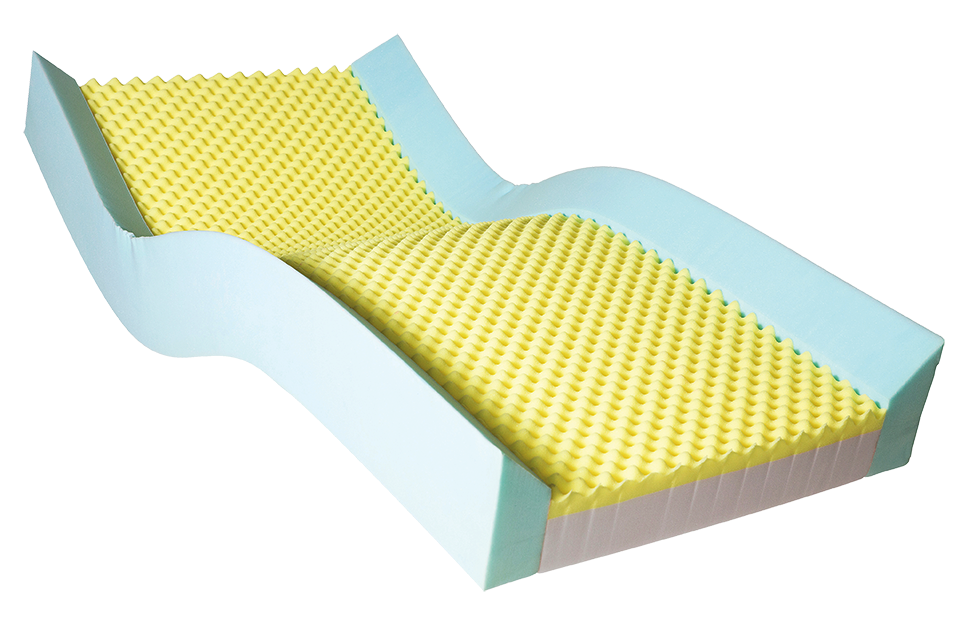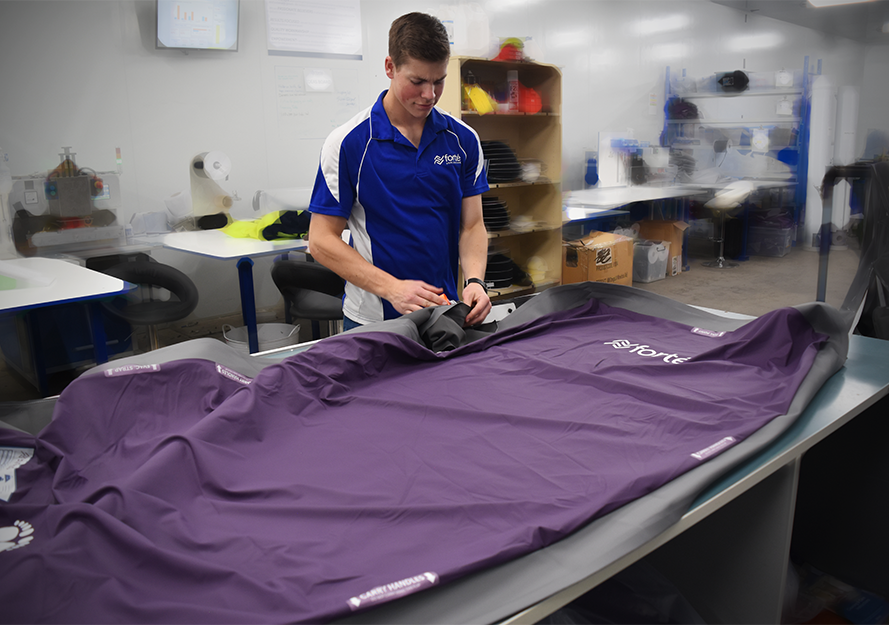Concave Safety Sides
Forté Mattress Concave Safety Sides
Concave Safety Sides are an accessory that can be added to any Forté mattress for those with falls risk. These unobtrusive raised sides encourage central patient positioning and gentle protection for patients inclined to turn out of bed. Concave safety sides can be used as an alternative to bed rails
Standard Thickness: 95mm, Standard Height/Slope: 245-150mm. Customisable
Features

SUBTLE PATIENT RESTRAINT
- Manufactured with quality foam which conforms to patient transfer and primary care whilst maintaining its profile.
- The modest curve is barely noticeable and does not impede primary patient care or general bedside nursing duties.
- Comfortable and protective
- Subtle Cradling effect, giving a non-restraining and secure feeling as opposed to bed rails
- Discourages independent exists from the bed

ENCOURAGES CENTRAL PATIENT POSITIONING
- Prevents patients rolling or falling off the mattress and reduces risk of entrapment for restless and agitated patients
- Central patient positioning ensures full therapeutic function of the mattress

AVAILABLE WITH ANY FORTÉ MATTRESS AND COVER
- Must be purchased in conjunction with a Forté mattress
- Learn more about our range of mattresses and covers
About Concave Safety Sides
Forté Customisations & Accessories

Falls Prevention

High Durability

Stability

Safety
WHY FOCUS ON FALLS?
According to the Australian Commission on Safety and Quality in Health Care, Each year, patients in Australian hospitals experience a large number of falls, which collectively cause significant harm.
In 2015–16, 1,756 such falls occurred in public hospitals. This equates to 4 falls causing harm per 10,000 hospitalisations in 2015–16 in Australian public hospitals.
Fall-related injury is one of the leading causes of hospital-acquired morbidity and mortality in older Australians, and leads to pain, bruising and lacerations and fractures. Falls can also lead to intracranial bleeding, which can cause confusion, drowsiness, clouding, loss of consciousness and headache. A fall can instil a fear of falling, in turn leading to a loss of confidence and decline in mobility, and an injurious fall can increase the likelihood of discharge to a residential aged care facility. Falls in the hospital which cause harm, such as intracranial injury, fractured neck or femur and other fractures, also prolong the length of stay.
Patients experiencing one of these falls remain in hospital for 18.8 days longer on average than patients who don’t experience this hospital-acquired complication. The national average cost per admitted acute overnight stay is $2,074. Each hospitalisation involving a hospital-acquired fall injury may therefore be associated with $38,991 in extra costs. In many cases, falls causing harm are preventable. Significant reductions in injurious fall rates are being achieved in some hospitals through preventive initiatives. The rate of falls at Principal Referral Hospitals† was 4 per 10,000 hospitalisations in 2015–16. If all Principal Referral Hospitals above this rate reduced their rate to 4 per 10,000 hospitalisations, then 251 falls causing harm would have been prevented, and more when other types of facilities are considered.
According to Address for correspondence: Dr Rob Morris, Health Care for Older People, Queen’s Medical Centre, Derby Road, Nottingham NG7 2UH, UK, No fall is harmless, with psychological sequelae leading to lost confidence, delays in functional recovery and prolonged hospitalisation. Yet falls are not true accidents and there is evidence that a coordinated multidisciplinary clinical team approach can reduce their incidence. Identification of multiple underlying risk factors coupled with clear interventions to ameliorate the impact of each has been shown to reduce the incidence of inpatient falls by 20–30%. The implementation of complex multiprofessional interventions is challenging and successful schemes seek to nurture a culture of vigilant safety consciousness in all staff at the clinical interface. Strong leadership and organisational oversight help to combine this cultural evolution with relevant evidence and rigorous measurement of performance to improve patient safety.
Accessories and customisations like concave safety sides protect the incidence of falls.

IMPORTANCE OF PATIENT SAFETY
Concave safety sides are an accessory that can be added to any Forté mattress to prevent risk of falls, enhancing the safety of patients.
According to the World Health Organisation, Patient Safety is a health care discipline that emerged with the evolving complexity in health care systems and the resulting rise of patient harm in health care facilities. It aims to prevent and reduce risks, errors and harm that occur to patients during the provision of health care. A cornerstone of the discipline is a continuous improvement based on learning from errors and adverse events.
The occurrence of adverse events due to unsafe care is likely one of the 10 leading causes of death and disability in the world. In high-income countries, it is estimated that one in every 10 patients is harmed while receiving hospital care. The harm can be caused by a range of adverse events, with nearly 50% of them being preventable. Each year, 134 million adverse events occur in hospitals in low- and middle-income countries (LMICs), due to unsafe care, resulting in 2.6 million deaths.
Globally, as many as 4 in 10 patients are harmed in primary and outpatient health care. Up to 80% of harm is preventable. The most detrimental errors are related to diagnosis, prescription and the use of medicines.
Investments in reducing patient harm can lead to significant financial savings, and more importantly better patient outcomes. An example of prevention is engaging patients, if done well, it can reduce the burden of harm by up to 15%.

VERSATILITY
With the Forté concave safety sides, no longer are individuals at risk of falls restricted to selecting a ‘concave side mattress’. Forté concave sides are an accessory that can be added to any mattress within our range – whether it be a low care or high care support surface.
The prescribing, selecting and trialling process remains the same as any mattress, and at the point of order, concave sides can be simply added in.
Concave sides are inbuilt within the mattress and constructed from an ultra-high density foam.

AUSTRALIAN MADE
The Forté production facility in Armidale is specifically dedicated to Medical Mattress’ design, development, and production. This ensures unrivalled expertise and process control for superior quality, value, and performance. Forté utilizes leading global technology and research in the design and development of each medical device. Products manufactured by Forté in Australia are produced in compliance with local regulatory standards and exceed clinical standards recommendations such as European Pressure Ulcer Advisory Panel, National Pressure Injury Advisory Panel and Pan Pacific Pressure Injury Alliance – a quality you can trust!
Australian made by Forté Healthcare in Armidale NSW, the Homecare ICON range is synonymous with quality, performance, longevity, and functionality and is trusted by leading Hospitals and healthcare professionals to deliver clinical results and positive outcomes.
Why is it important to purchase Australian made products?
By purchasing products from Forté you are investing into the future of pressure injury prevention in Australia, creating regional jobs and boosting our economy for the better of everyone. Australian Made for Australian Care.


Manufacturing
Leveraging clinical expertise, with leading raw material technology and in-house manufacturing capabilities Forté Healthcare ensures optimal outcomes for pressure injury prevention, infection control and patient comfort.

Hear what Health Professionals say About Forté Healthcare Mattresses…

You’re Covered by Forté Healthcare’s ‘Successful Solution Guarantee’
At Forté Healthcare, we are so confident in the care and performance our support surfaces deliver, that we back our products and expertise with our ‘Successful Solution Guarantee’.
Here’s how it works:
Our team of specialists will help you navigate our product range to correctly match our support surfaces with your care environment and patient risk profile. This ensures you achieve the highest levels of patient care and pressure injury prevention.
If, for whatever reason the product we recommend isn’t helping you achieve the outcome you expected, we’ll work with you until it is. And in the unlikely event we still cannot provide the right solution.
We’ll refund you 100% of the charges to date.










